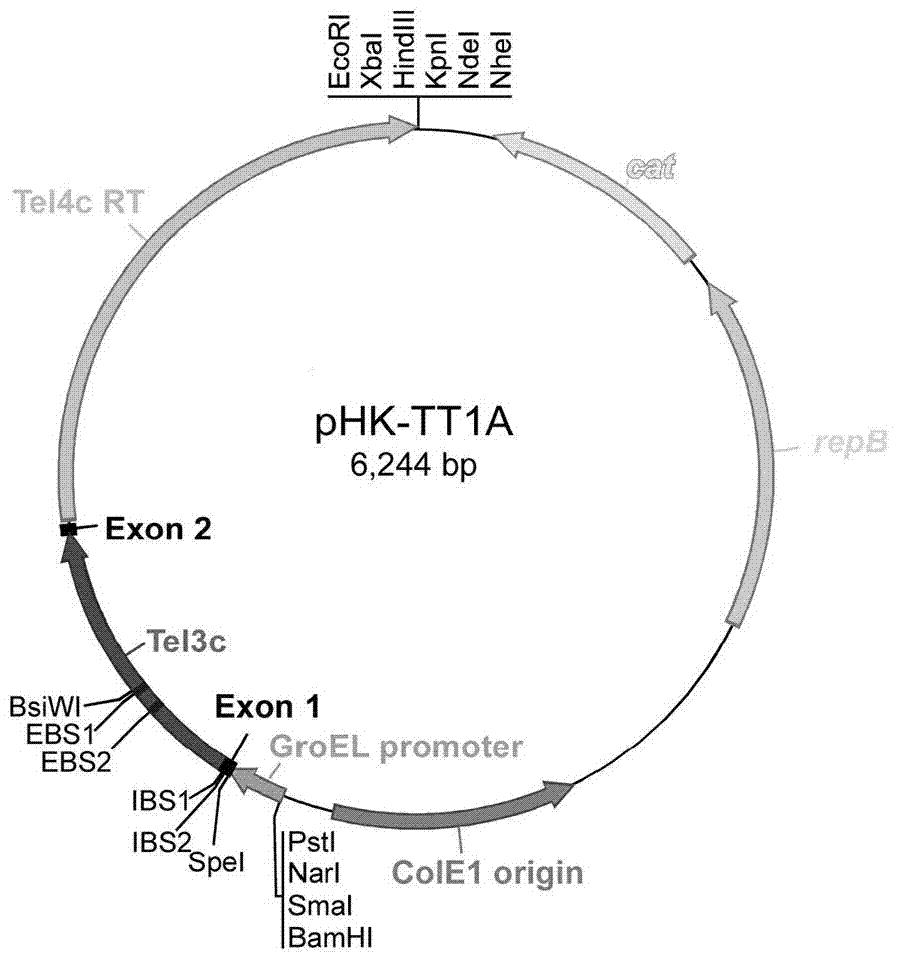Genetic element applicable to genetic modification of thermophilic microorganisms, carrier and application thereof
A technology of thermophilic microorganisms and genetic transformation, which is applied to the genetic elements of thermophilic microorganisms genetic transformation and its carrier and application field, can solve the problems that thermophilic microorganisms cannot be applied, and achieve low conversion efficiency requirements, high gene inactivation efficiency, Wide host range effect
- Summary
- Abstract
- Description
- Claims
- Application Information
AI Technical Summary
Problems solved by technology
Method used
Image
Examples
Embodiment 1
[0038] Whole-gene synthesis of the thermophilic type II intronic element TeI3c-4c:
[0039] Thermosynechococcus elongates BP-1 strain contains 28 type IIB introns. They are closely related and are thought to have evolved from a common ancestor, with lateral transfer into the genome of the microorganism [8,12,13]. It synthesized the TeI3c type II intron gene (873nt, 5'-end SpeI, 3'-end PstI) while mutating its 20, 319, 321, 337, 339 A, T, A, T, A sequences into T, A, G respectively , C, T form the SpeI-BsiwI restriction site (sequence). The SpeI-BsiwI digestion fragment is 357bp long, covering IBS1-IBS2, EBS1, EBS2, and can be quickly replaced with the target DNA recognition sequence by enzyme digestion and ligation. In addition, wild-type TeI3c itself does not encode an RT enzyme, and the RT enzyme encoded by TeI4c can promote the "retrohoming" of TeI3c. Therefore, the gene encoding the RT enzyme of TeI4c was synthesized (1701nt, 5'-end PstI, 3'-end XhoI, sequence) and conn...
Embodiment 2
[0063] Construction of the high-temperature microbial gene targeting vector pHK-TT1A based on TeI3c-4c——Thermotargetron
[0064] The process of constructing the thermotargetron plasmid pHK-TT1A plasmid is divided into three steps:
[0065] In the first step, the C.thermcellum chaperone protein Cpn10 (Clo1313_0432) promoter PgroEL was cloned upstream of the TeI3c intron / TeI4RT element. The specific process is to use Ct_PgroEL5-BamHI, Ct_PgroEL3-SpeI-XhoI-EcoRI primers (Table 2) to amplify the groEL promoter from the genome of Clostridium thermocellum DSM1313, and the PCR product BamHI and EcoRI are digested and ligated into the pIKM1 plasmid[14] Obtain pIKM1PgroEL plasmid;
[0066] In the second step, the 897nt TeI3c intron DNA sequence (SpeI / PstI) synthesized in Example 1 was cloned into the corresponding site of the pIKM1PgroEL plasmid after double digestion with SpeI and PstI to obtain the pIKM1PgroEL-TeI3c plasmid; the 1710nt TeI4c synthesized in Example 1 RT enzyme gene ...
Embodiment 3
[0072] The function of the thermophilic type II intron element TeI3c-4c was tested in Escherichia coli as a host:
[0073] 1) Effect of temperature on the "homing" efficiency of TeI3c-4c type II intron in E. coli (TeI3c-4c "homing" test):
[0074] The principle of the TeI3c-4c "homing" test is: the DIV region carries the TeI3c-4c intron donor plasmid pACD2X-TeI3c-4c[15] containing the T7 promoter (acgcgtaatacgactcactataggg) (see Figure 4 ) can recognize and insert the ampicillin-resistant intron acceptor plasmid pBRR-3C E1, E2 (exon) site (Table 1). The pBRR-3C plasmid carries a tetracycline resistance gene without a promoter behind the E1 and E2 sites. When the TeI3c intron of the donor plasmid "homing" to the E1 and E2 sites of the acceptor plasmid, the T7 promoter carried in the DIV region of the donor plasmid promotes the expression of the tetracycline resistance gene, so that the intron "homing" occurs Escherichia coli strains acquire tetracycline resistance, so the "h...
PUM
 Login to View More
Login to View More Abstract
Description
Claims
Application Information
 Login to View More
Login to View More - R&D
- Intellectual Property
- Life Sciences
- Materials
- Tech Scout
- Unparalleled Data Quality
- Higher Quality Content
- 60% Fewer Hallucinations
Browse by: Latest US Patents, China's latest patents, Technical Efficacy Thesaurus, Application Domain, Technology Topic, Popular Technical Reports.
© 2025 PatSnap. All rights reserved.Legal|Privacy policy|Modern Slavery Act Transparency Statement|Sitemap|About US| Contact US: help@patsnap.com



